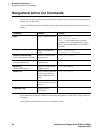
2
Installing Hardware for the G700 Media Gateway and S8300 Media Server
Getting Started
Installation and Upgrades for G700 and S8300 71
December 2003
Media Modules
Media modules are optional, plug-in circuit assemblies. They provide traditional interfacing of service
provider network access solutions (such as T1/E1) and connections to TDM-based endpoints (such as
DCP digital phones and analog phones). The available media modules are (as shown in Figure 2, Media
modules, on page 71):
Figure 2: Media modules
1 Avaya MM710 T1/E1 Media Module
2 Avaya MM760 VoIP Media Module for additional VoIP resources
3 Avaya MM711 Analog Media Module for connection to 8 analog stations or CO trunks
4 Avaya MM712 DCP Media Module for connection to 8 DCP stations
5 Avaya MM720 BRI Media Module for connection to 8 ports for international BRI trunks
For detailed descriptions of the media modules see Hardware Guide for Avaya Communication Manager.
NOTE:
A shielded cable for the MM710 Media Module is required to meet emission
requirements in European Union countries. The use of a shielded cable for the MM710 is
preferred for installations worldwide.
The media modules enable the G700, with its primary controller, to host a variety of functions ranging
from IP phones to traditional analog telephony ports. The media modules contain trunk or line interfaces
and their associated circuitry. Each of the four media module slots has access to the 512-time-slot TDM
bus, a 10/100 base T port, power (+5V, -48 V phantom) and ground. Each media module can be accessed
and reset from the G700 Media Gateway Processor (MGP) or from the primary controller, and its status is
indicated by an LED display.
E1/T1 EIA 530A DCE
ALM
TST
ACT
SIG
EISO EMSM EOSI
1
ALM
TST
ACT
2
ALM
TST
ACT
123456 87
3
ALM
TST
ACT
123456 87
4
mmdc7 KLC 082202
ALM
TST
ACT
123456 87
5


















